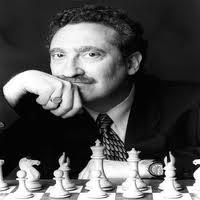
Pandolfini's Puzzler #31 - Be Wise, Be Sure! Rooks Belong Behind!
Professor: Class, it’s good to see you. What brings you to this part of the world?
Zephyr: I’m here for a chess class. I suspect so is Lucian.
Lucian: Yeah, I guess that’s why I’m here, too.
Zephyr: Professor, weren’t you going to talk about rook endgames today?
Professor: That’s right. Well, less about rook endgames and more about the rook in a few endgame positions.

Zephyr: That sounds kind of like wordplay, Professor.
Lucian: But it does encourage me to tell a joke.
Zephyr: Oh, let’s hear it.
Lucian: Okay, here it is: Are you trying to rook us?
Zephyr: Thanks for alerting us to the joke, Lucian. Are we supposed to laugh now?
Professor: That’s enough of that. What I wanted to talk about a little bit was the saying “rooks belong behind passed pawns.” Can either of you explain what that means?
Zephyr: I have a feeling it means that much of the time you should try to place your rooks behind advancing pawns.
Professor:And why is that?
Lucian: I think that’s because, as a pawn advances up the board, the mobility of the rook in front of the pawn decreases while the mobility of the rook behind the same pawn increases.

Zephyr: That was quite a mouthful, Lucian. But your point does seem to be true, whether the rook is defending or attacking.
Professor: Quite so. But let’s get down to business. Consider a simple position, namely, the following one.
Professor: In our diagram, White is up a pawn and it’s White’s turn. Meanwhile, White has just advanced the pawn from a6 to a7. Whose rook is better placed, White’s or Black’s?
Zephyr: Black’s rook seems better placed. It’s positioned behind the passed pawn.
Lucian: White’s rook doesn’t even have a good move. If the white rook moves, White at least loses the pawn. And that’s a draw.
Professor: To be sure, to be able to move the white rook freely, White’s king must first defend the pawn. Once White’s king defends the a-pawn, however, what happens then?

Zephyr: If it’s White’s turn, White moves the rook to a good and safe square. That wins, since Black will have to surrender his rook for the pawn before it queens or immediately after it queens.
Professor: Good, but what happens if it’s Black’s turn?
Lucian: If it’s Black’s turn to move, that’s different. Black can draw by checking the white king, which will then have no place to hide. If White’s king then comes back toward the black rook, trying to end the checks, the black rook once again stations itself behind the passed pawn, and no progress has been made. The position is drawn.
Professor: How about if we changed the placement of the black king? Obviously, if the black king started on f6, White to move would then have 1. Rf8+. That gains time, and the pawn promotes next move, after Black gets out of check, say by 1…Kg7. But suppose the black king started on f7 instead of f6, as in diagram 2. Does that change matters?
Question 1: In diagram 2, what is White’s best move?
Zephyr: Oh, that’s an old trick, Professor. You don’t even need to study the endgame to know about that tactic.
Lucian: You mean, even checkers players could get that one right?
Professor: Let’s not pick on checkers players. They can be pretty smart, and checkers is a great game, too.

Zephyr: If you say so, Professor.
Professor: Anyhow, you’re right about the tactic. I’ve shown you that idea before. I like to call that skewer tactic the “rook trick” or “rook trick number one.”
Lucian: Does that mean there’s a rook trick number two? If so, can you show it to us?
Professor: Yes, there is a rook trick number two, but we’re not going to look at it now. Rather, go back a move, before White has precipitously played a6-a7. That is, before arriving at the position of diagram 1.
Question 2: In the above diagram, should White play 1. a6-a7?
Lucian: Diagrams 1 and 3 are practically the same. But I think the small difference in setup could make a big difference in result.
Zephyr: Besides, Professor, you’ve already answered the question for us by implication.
Professor: I’m glad to hear you say that. It appears you have been listening. Nevertheless, can you provide some sample analysis to explain your reasoning?
Almost in no time, each student had essentially the same variation. That prompted the Professor to move the discussion ahead a tad.
Professor: Very good. Here’s what I’d like to try now. I’m going to show you three more positions. Please analyze diagrams 4-6, giving me what seems to be the right outcome and why.
Lucian: Did you say three positions? That’s a lot of work.
Professor: Oh, I don’t think so. The positions aren’t very hard, especially for veteran analysts such as the two of you. Besides, they can be treated conceptually, almost without concrete analysis.
Zephyr: Okay, Professor, what are the positions in question?
Question 3: Does the extra h-pawn change the result?
Question 4: Using the g-pawn for king shelter, can White now force a win?
Question 5: Does having an extra f-pawn, instead of an extra g-pawn, change the position’s evaluation?
Professor: There you have it: three similar positions, in each case White having an additional pawn. I’d like to know how the additional pawn affects each position, if it does, and if the result is based on White having the move. Of course, I expect you to substantiate your thinking with explanation and, if necessary, actual moves.
Zephyr: The problems may not be hard, but do we have to write down a lot of moves?
Lucian: Together with explanations?
Professor: I don’t think you need to write down many moves. As long as you can justify your conclusions. Oh, and you’re not done yet.
Zephyr: What do you mean, Professor?
Lucian: Is there something else?
Professor: It must have slipped my mind. There’s another position. You might as well take a look at it now.
Question 6: Does White have a forced win?
Professor: In the previous few examples, we’ve been adding a second pawn for White, so I thought I’d balance it out a smidgen and add a pawn for Black.
Lucian: That was very thoughtful of you, Professor.
Zephyr: I think this is one of those lessons where maybe you should summarize what we must do.
Professor: I’d be happy to. Please do the following.
In summary, answer questions 1 through 6 and give explanations where helpful or needed.
Zephyr: Gee, thanks Professor.
Lucian: Your summary was very helpful.
Answers below - Try to solve Professor Pando's puzzle first!
ANSWER #31
Answer 1: For question 1, White wins by 1. Rh8!. After 1…Rxa7, which is essentially forced, Black drops the rook to the skewer, 2. Rh7+. Take note: If it were Black’s move to start with, Black could hold the position by 1…Kg7!, preventing a rook trick.
Answer 2: For question 2, the answer is that White shouldn’t play 1. a7?. That only leads to a draw, since the black rook can then annoy the white king with pesky checks, starting with 1…Rc1+, and the white king has no place to hide.
Instead, White wins by 1. Kb6. A sample variation is 1…Rb1+ 2. Ka7 Rb2 3. Rb8 Ra2 4. Kb7 Rb1+ 5. Ka8 Ra1 6. a7 Ra1 7. Kb7 Rb1+ 8. Kc6 Rc1+ 9. Kd5 Rd1+ 10. Ke4 Re1+ 11. Kf3 Rf1+ 12. Kg2 Ra1 13. a8/Q and wins.
Answer 3: For question 3, the answer is that even with an extra h-pawn the position is still drawn. Moreover, it doesn’t matter who moves first.
Answer 4: For question 4, the answer is that even having an extra g-pawn, with the ability of White’s king to find shelter from checks, White still can’t force a win. The situation is still drawn. Nor does it matter who moves first.
Answer 5: For question 5, the answer is that an extra f-pawn does make a difference, and it doesn’t matter who moves first. White simply advances the f-pawn up the board. It doesn’t even need protection. Let’s say it’s White’s move to start. A sample variation would be 1. f4 Ra2 2. f5 Ra1 3. f6+.
Obviously, the pawn can’t be captured, 3…Kxf6, since White would then with 4. Rf8+. But no better is 3…Kh7, since 4. f7 then wins. Meanwhile, 3…Kf7 runs right into another rook trick, 4. Rh8!.
Answer 6: For question 6, the answer is that White wins with 1. e6!.
If Black then plays 1…Kxe6, White wins with 2. Re8+.
If Black instead plays 1…fxe6, White wins with 2. Rh8 -- another rook trick.
Finally, if Black plays a temporizing move like 1…Ra2, White wins with 2. exf7 Kxf7 3. Rh8 -- a closing rook trick.
Take note
Occasionally, a rook can function adequately from in front of a pawn, but most of the time rooks contend with advancing pawns better from behind. When placement behind a passed pawn is not possible or desirable, a rook can often operate beautifully from the flank, especially if it can adequately harass the opposing king. To that end, such a pestering rook generally gets more annoying the farther away it is from its intended target. That way, the rook itself is harder to harass. We say that a rook sufficiently far away to be able to function at full strength has the so-called “checking distance.”
RELATED STUDY MATERIAL
- Practice - the king and rook mate, so once you've won the enemy rook, you can still make a checkmate;
- PlayfulSquirrel shows the same ideas, with a few more pawns on the board;
- Now you're ready for the most complicated example in our video library!






